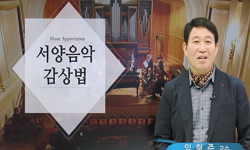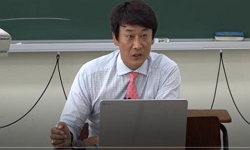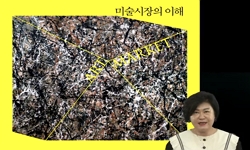Opera is ‘a human story expressed in music’ representing the diverse aspects of human life. Opera is a comprehensive work of art representing the vivid human life through various elements such as vocal and orchestral music, stage setting, and ball...
http://chineseinput.net/에서 pinyin(병음)방식으로 중국어를 변환할 수 있습니다.
변환된 중국어를 복사하여 사용하시면 됩니다.
- 中文 을 입력하시려면 zhongwen을 입력하시고 space를누르시면됩니다.
- 北京 을 입력하시려면 beijing을 입력하시고 space를 누르시면 됩니다.
오페라 '마술피리'에서 등장 인물의 신분에 따른 아리아 양식을 중심으로 한 감상 지도 방안 연구 = On teaching Method for Appreciating the Aria Styles Based on Protagonists's Social Status in The Magic Flute
한글로보기https://www.riss.kr/link?id=T11334636
- 저자
-
발행사항
청원군: 한국교원대학교 교육대학원, 2008
-
학위논문사항
학위논문(석사) -- 한국교원대학교 교육대학원 , 음악교육학과 초등음악교육전공 , 2008. 2
-
발행연도
2008
-
작성언어
한국어
- 주제어
-
DDC
372.87
-
발행국(도시)
충청북도
-
형태사항
viii, 125p.: 삽도; 26cm
-
일반주기명
지도교수 : 이남재
- 소장기관
-
0
상세조회 -
0
다운로드
부가정보
다국어 초록 (Multilingual Abstract)
The Magic Flute by Wolfgang Amadeus Mozart appears in "The Dramatic Music" unit of the 6th grade music textbook. It is suitable work for the students who have no previous experience of opera because not only for its instructive fairy-tale story but also for its attractive music provides ample opportunity for whetting an interest for beginners.
One of the prominent feature of The Magic Flute is its distinct aria styles according to the protagonists's social status: highborn characters sing arias in seria style, while the lowborns sing buffa or folk style songs. For this study, the focal point for appreciating The Magic Flute is centered on such features.
At first, an animation version of The Magic Flute is shown to the students in order to develop their interest and curiosity.
Next, through reading opera scripts and doing role plays, the students are encouraged to understand the story and grasp the concept of social status of the protagonists and their relationships.
Thirdly, the students examine the treatment of the social status by gender of the protagonists. They are encouraged to found out the difference of musical expressions which reflect the protagonists's social status. As a preparation for this, activities such as comparing the libretto; drawing a linear score following the melodic shape; playing musical instruments and walking to the rhythmic patterns; and expressed the atmosphere of the opera with drawing a picture were encouraged.
Fourthly, after summarizing the characteristics of the arias in opera seria and the opera buffa, students are encouraged to recognize those traits in other arias by Mozart. Arias of opera seria tends to be elegant and noble, while the arias of opera buffa are mostly delightful and simple.
Finally, the animation version of the opera is shown to the students once more. This is intended for them to give another chance to recognize the relationship between the protagonists's social status and their musical expressions in the musical context.
In order to appreciate an opera properly, just know its story or understand its general idea is insufficient. Figuring out the different musical expressions of its characters as well as comparing their own experiences with them, even elementary students also can experience opera aesthetically.
Opera is ‘a human story expressed in music’ representing the diverse aspects of human life. Opera is a comprehensive work of art representing the vivid human life through various elements such as vocal and orchestral music, stage setting, and ballet. Since opera reveals the mental world of its characters through its libretto and music, appreciating the opera provides the opportunity to develop an insight into our own life. Therefore, it is pertinent for even for 6th graders to appreciate the opera.
The Magic Flute by Wolfgang Amadeus Mozart appears in "The Dramatic Music" unit of the 6th grade music textbook. It is suitable work for the students who have no previous experience of opera because not only for its instructive fairy-tale story but also for its attractive music provides ample opportunity for whetting an interest for beginners.
One of the prominent feature of The Magic Flute is its distinct aria styles according to the protagonists's social status: highborn characters sing arias in seria style, while the lowborns sing buffa or folk style songs. For this study, the focal point for appreciating The Magic Flute is centered on such features.
At first, an animation version of The Magic Flute is shown to the students in order to develop their interest and curiosity.
Next, through reading opera scripts and doing role plays, the students are encouraged to understand the story and grasp the concept of social status of the protagonists and their relationships.
Thirdly, the students examine the treatment of the social status by gender of the protagonists. They are encouraged to found out the difference of musical expressions which reflect the protagonists's social status. As a preparation for this, activities such as comparing the libretto; drawing a linear score following the melodic shape; playing musical instruments and walking to the rhythmic patterns; and expressed the atmosphere of the opera with drawing a picture were encouraged.
Fourthly, after summarizing the characteristics of the arias in opera seria and the opera buffa, students are encouraged to recognize those traits in other arias by Mozart. Arias of opera seria tends to be elegant and noble, while the arias of opera buffa are mostly delightful and simple.
Finally, the animation version of the opera is shown to the students once more. This is intended for them to give another chance to recognize the relationship between the protagonists's social status and their musical expressions in the musical context.
In order to appreciate an opera properly, just know its story or understand its general idea is insufficient. Figuring out the different musical expressions of its characters as well as comparing their own experiences with them, even elementary students also can experience opera aesthetically.
국문 초록 (Abstract)
초등학교 6학년 ‘극음악’ 단원에는 모차르트의 오페라『마술피리』를 감상하도록 제시되어 있다. 이 오페라는 내용이 동화적이고 교훈적이며, 다양한 음악적 양식들이 조화롭게 어우러져 있어 초등학생이 처음 접하기에 적합한 작품이다.
『마술피리』의 여러 음악적 특징 중 등장 인물의 신분에 따라 아리아의 양식이 달라진다는 점은 초등학교 6학년 학생들에게 쉽게 이해될 수 있다. 신분이 높을수록 정가극(오페라 세리아)적인 아리아를 부르고, 신분이 낮을수록 희가극(오페라 부파와 징슈필)적인 아리아를 부른다는 것을 알고 나면 누구나 쉽게 이 두 가지 양식을 알아들 수 있기 때문이다.
본 연구에서는 이러한 측면을 중심으로 초등학교 6학년 학생을 대상으로 하는 오페라 『마술피리』감상 지도 방안을 크게 다섯 단계로 구안해 보았다.
첫째, 오페라에 대한 흥미와 호기심을 느끼도록 하기 위해 애니메이션 오페라『마술피리』를 감상하고, 첫 느낌과 인상적인 부분, 알고 싶은 점 등을 발표하게 하였다.
둘째, 오페라는 이야기를 바탕으로 하는 극음악이므로 대본 읽고 연극하기 활동을 통해 전체적인 내용을 이해하고 등장 인물의 신분, 성격, 관계 등을 파악하게 하였다.
셋째, 신분이 다른 남자 인물과 여자 인물의 아리아를 비교 감상해 봄으로써 신분에 따른 음악적 표현의 차이를 살펴보았다. 이를 위해 가사 내용 비교하기, 선율의 흐름을 따라 가락선 악보 그리기, 리듬에 맞춰 리듬악기 연주하기 및 걷기, 곡의 분위기를 그림으로 나타내기 등의 활동을 유도하였다.
넷째, 정가극과 희가극 아리아의 특징을 정리하고, 모차르트의 다른 오페라 아리아를 이 두 양식으로 구분해 보게 하였다. 정가극의 아리아는 우아하고 고상하며 난이도가 높은 아리아 양식으로, 신분이 높은 인물이 주로 부르나, 희가극 의 아리아는 흥겹고 단순하여 따라 부르기 쉬우므로 신분이 낮은 인물이 주로 부른다는 것을 쉽게 구별할 수 있었다.
마지막으로, 짧게 축약된 애니메이션 오페라 『마술피리』를 다시 감상해 봄으로써 신분에 따른 아리아 양식의 차이를 실제 오페라의 흐름 속에서 적용하고, 오페라의 전체적인 특징과 구성요소를 살펴보는 활동을 하였다.
이 연구를 통해 오페라 감상 지도가 오페라의 개념이나 극적인 내용을 이해시키기 위한 지도로 그치는 것이 아니라, 등장 인물에 따라 음악적 표현이 달라지는 것을 ‘알아듣기’하고, 학생들의 삶과 등장 인물들의 음악으로 표현된 삶을 연관시켜 생각하는 감상을 하게 함으로써 초등학생들에게도 심미적으로 오페라를 체험할 수 있는 경험을 제공할 수 있을 것으로 기대된다.
오페라는 인간 삶의 다양한 모습이 구체적으로 드러나 있는 ‘음악으로 표현한 인생 이야기’라고 할 수 있다. 인간이라면 누구나 겪는 희로애락의 현실 세계 이야기를 성악과 관현악 반주,...
오페라는 인간 삶의 다양한 모습이 구체적으로 드러나 있는 ‘음악으로 표현한 인생 이야기’라고 할 수 있다. 인간이라면 누구나 겪는 희로애락의 현실 세계 이야기를 성악과 관현악 반주, 무대 장치, 발레 등 여러 미적 요소로 표현한 종합적인 음악이다. 이처럼 오페라는 등장 인물의 내면세계가 가사와 음악으로 생동감 있게 표출되기 때문에 오페라 감상 활동은 자신의 내면을 돌아보고 삶을 통찰할 기회가 될 수 있다. 따라서 자아 정체성이 형성되는 청소년기를 시작하는 초등학교 6학년 학생들에게 오페라를 감상하게 하는 일은 매우 시의적절하다고 여겨진다.
초등학교 6학년 ‘극음악’ 단원에는 모차르트의 오페라『마술피리』를 감상하도록 제시되어 있다. 이 오페라는 내용이 동화적이고 교훈적이며, 다양한 음악적 양식들이 조화롭게 어우러져 있어 초등학생이 처음 접하기에 적합한 작품이다.
『마술피리』의 여러 음악적 특징 중 등장 인물의 신분에 따라 아리아의 양식이 달라진다는 점은 초등학교 6학년 학생들에게 쉽게 이해될 수 있다. 신분이 높을수록 정가극(오페라 세리아)적인 아리아를 부르고, 신분이 낮을수록 희가극(오페라 부파와 징슈필)적인 아리아를 부른다는 것을 알고 나면 누구나 쉽게 이 두 가지 양식을 알아들 수 있기 때문이다.
본 연구에서는 이러한 측면을 중심으로 초등학교 6학년 학생을 대상으로 하는 오페라 『마술피리』감상 지도 방안을 크게 다섯 단계로 구안해 보았다.
첫째, 오페라에 대한 흥미와 호기심을 느끼도록 하기 위해 애니메이션 오페라『마술피리』를 감상하고, 첫 느낌과 인상적인 부분, 알고 싶은 점 등을 발표하게 하였다.
둘째, 오페라는 이야기를 바탕으로 하는 극음악이므로 대본 읽고 연극하기 활동을 통해 전체적인 내용을 이해하고 등장 인물의 신분, 성격, 관계 등을 파악하게 하였다.
셋째, 신분이 다른 남자 인물과 여자 인물의 아리아를 비교 감상해 봄으로써 신분에 따른 음악적 표현의 차이를 살펴보았다. 이를 위해 가사 내용 비교하기, 선율의 흐름을 따라 가락선 악보 그리기, 리듬에 맞춰 리듬악기 연주하기 및 걷기, 곡의 분위기를 그림으로 나타내기 등의 활동을 유도하였다.
넷째, 정가극과 희가극 아리아의 특징을 정리하고, 모차르트의 다른 오페라 아리아를 이 두 양식으로 구분해 보게 하였다. 정가극의 아리아는 우아하고 고상하며 난이도가 높은 아리아 양식으로, 신분이 높은 인물이 주로 부르나, 희가극 의 아리아는 흥겹고 단순하여 따라 부르기 쉬우므로 신분이 낮은 인물이 주로 부른다는 것을 쉽게 구별할 수 있었다.
마지막으로, 짧게 축약된 애니메이션 오페라 『마술피리』를 다시 감상해 봄으로써 신분에 따른 아리아 양식의 차이를 실제 오페라의 흐름 속에서 적용하고, 오페라의 전체적인 특징과 구성요소를 살펴보는 활동을 하였다.
이 연구를 통해 오페라 감상 지도가 오페라의 개념이나 극적인 내용을 이해시키기 위한 지도로 그치는 것이 아니라, 등장 인물에 따라 음악적 표현이 달라지는 것을 ‘알아듣기’하고, 학생들의 삶과 등장 인물들의 음악으로 표현된 삶을 연관시켜 생각하는 감상을 하게 함으로써 초등학생들에게도 심미적으로 오페라를 체험할 수 있는 경험을 제공할 수 있을 것으로 기대된다.
목차 (Table of Contents)
- Ⅰ. 서론 = 1
- 1. 연구의 필요성 및 목적 = 1
- 2. 연구의 내용 및 방법 = 5
- 3. 연구의 제한점 = 6
- Ⅱ. 이론적 배경 = 7
- Ⅰ. 서론 = 1
- 1. 연구의 필요성 및 목적 = 1
- 2. 연구의 내용 및 방법 = 5
- 3. 연구의 제한점 = 6
- Ⅱ. 이론적 배경 = 7
- 1. 음악 감상 교육 = 7
- 2. 모차르트 오페라의 개관 = 10
- Ⅲ. 오페라 『마술피리』의 작곡 배경 = 25
- 1. 대본 작업 및 작곡 경위 = 25
- 2. 오페라『마술피리』와 프리메이슨 = 27
- Ⅳ. 『마술피리』의 감상 지도 내용 및 지도 방안 = 33
- 1.『마술피리』의 감상 지도 내용 = 33
- 가.『마술피리』의 주요 인물의 신분과 성격 = 33
- 나.『마술피리』의 음악적 특징 = 36
- 다. 등장 인물의 아리아 분석 = 38
- 2. 오페라『마술피리』의 단계별 감상 지도 방안 = 63
- 가. ‘첫 느낌 단계’ 지도 방안의 예 = 75
- 나. ‘내용 이해 단계’ 지도 방안의 예 = 76
- 다. ‘분석적 감상 단계’ 지도 방안의 예 = 87
- 라. ‘종합적 감상 단계’ 지도 방안의 예 = 107
- 마. ‘적용 및 심화 감상 단계’ 지도 방안의 예 = 111
- Ⅴ. 요약 및 제언 = 115
- 참고문헌 = 119
- ABSTRACT = 123












